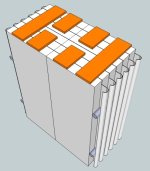liveforphysics
100 TW
Pouch cells conduct heat well from the edges. Its like 20% Cu/Al solid through that plane.
Clamp them well and give a short and low Rth path to ambient from all edges you can. 3 edges is very possible, the 4th is more difficult with the tabs, but all the open space around a high current density and high temperature region of cells for ducted forced air to work well.
Clamp them well and give a short and low Rth path to ambient from all edges you can. 3 edges is very possible, the 4th is more difficult with the tabs, but all the open space around a high current density and high temperature region of cells for ducted forced air to work well.





